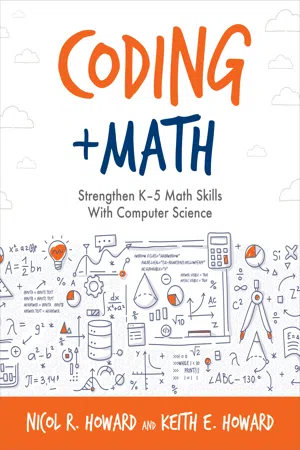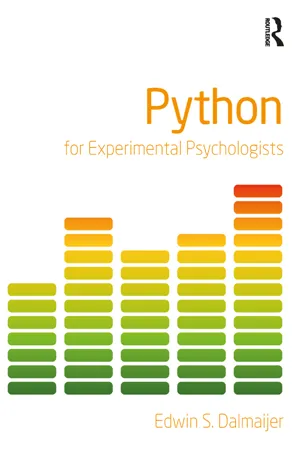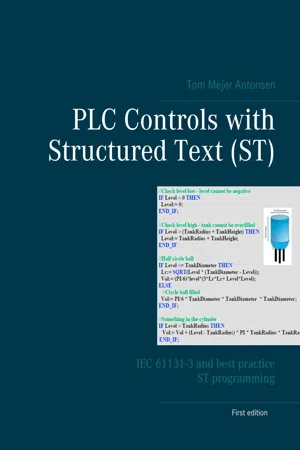Computer Science
Variables in C
In C programming, variables are used to store and manipulate data. They have a data type that determines the kind of data they can hold, such as integers, floating-point numbers, characters, or pointers. Variables are declared with a specific name and can be assigned values, which can be changed during the program's execution.
Written by Perlego with AI-assistance
7 Key excerpts on "Variables in C"
Learn about this page
Index pages curate the most relevant extracts from our library of academic textbooks. They’ve been created using an in-house natural language model (NLM), each adding context and meaning to key research topics.
- eBook - ePub
Coding + Math
Strengthen K–5 Math Skills With Computer Science
- Nicol R. Howard(Author)
- 2020(Publication Date)
This chapter explores the fundamental concept of data and variables as they relate to coding. Definitions and examples are shared along with a project to explore variables. Also included in this chapter: • Definitions of data types and how they are declared in different programming languages • Standards-aligned variable project using Visual Studio • Feature: “Coding + Math during Preservice Teacher Development” by Dr. Cory Gleasman • Resources for learning more about data and variables G iven the importance of data as one of the foundational building blocks of any program, it is important that beginning programmers have a solid foundation in how the variables that hold data are created and manipulated in code. Even the best of programming efforts can be derailed by errors related to using variables that are of the incorrect, or incompatible, types for the data being stored in them. However, before we discuss the variables and their types, a quick primer on how computers actually store data, any kind of data, will be helpful in shaping overall understanding of how computer programs work. All data on computers are represented as a series of binary numbers stored in bits. Binary numbers have only one of two values: 0 or 1. A bit is the smallest unit of information storage on a computer; however, the smallest unit that can be given an address by a computer is a byte, which is comprised of eight bits. Although having students learn the base-2 system of mathematics is not particularly useful for learning programming, they should at least understand that each data type has a limited number of bytes allocated to it, as well as restrictions on the kinds of data each can store. It needs to be understood that once a section of memory is allocated to a variable, that space cannot be used for any other purpose within that program for the duration it is running - eBook - ePub
- Bill Sempf, Charles Sphar, Stephen R. Davis(Authors)
- 2010(Publication Date)
- For Dummies(Publisher)
Chapter 2: Living with Variability — Declaring Value-Type Variables In This Chapter Visiting the train station — the C# variable as storage locker Using integers — you can count on it Handling fractional values — what’s half a duck? Declaring other types of variables — dates, characters, stringsHandling numeric constants — Π in the skyChanging types — cast doesn’t mean toss Letting the compiler figure out the type — var magicT he most fundamental of all concepts in programming is that of the variable. A C# variable is like a small box in which you can store things, particularly numbers, for later use. (The term variable is borrowed from the world of mathematics.)Declaring a VariableUnfortunately for programmers, C# places several limitations on variables — limitations that mathematicians don’t have to consider. This chapter takes you through the steps for declaring, initializing, and using variables. It also introduces several of the most basicdata types in C#.When the mathematician says, “ n is equal to 1,” that means the term n is equivalent to 1 in some ethereal way. The mathematician is free to introduce variables in a willy-nilly fashion. For example, the mathematician may say this:x = y 2 + 2y + yif k = y + 1 thenx = k 2Programmers must define variables in a particular way that’s more demanding than the mathematician’s looser style. For example, a C# programmer may write the following bit of code: int n; n = 1;The first line means, “Carve off a small amount of storage in the computer’s memory and assign it the name n. ” This step is analogous to reserving one of those storage lockers at the train station and slapping the label n on the side. The second line says, “Store the value 1 in the variable - eBook - ePub
Electronics for Artists
Adding Light, Motion, and Sound to Your Artwork
- Simon Quellen Field, Simon Quellen Field(Authors)
- 2015(Publication Date)
- Chicago Review Press(Publisher)
x .If you want to prevent a variable from being reclaimed when it goes out of scope, you can declare it static. A static variable keeps its value across function calls or when exiting blocks. Complex Data Types Sometimes you want to group data together. The simplest example of this is the array.An array is just a bunch of simple data types strung together one after the other so they can be indexed by a counting variable. You have used arrays several times in the examples in this book. Arrays are declared by putting their size in square brackets after the name of the variable:If the array is initialized by putting values in curly braces after an equal sign, then the compiler can count the number of items itself, and you can omit the number in the square brackets: You can retrieve the values in the array by using an index inside square brackets: Sometimes you want to group different types of data into one bundle, to keep them all in one place. You use a structure for that: You can then declare an instance of that structure by using the structure name: To use the variables inside the structure, join them to the variable with a period: Structures can be initialized by a function called a constructor. It is a function that has no return value (not even void) and has the same name as the structure: Arguments to the constructor are passed in when the variable is declared: Structures can have functions inside them besides the constructor. Those functions can see the variables inside the structure and can change them.These functions inside structures are called “methods.” The change() method in the Throb structure changes the brightness of an LED every time it is called. It remembers the previous brightness so it can slowly ramp the brightness up and down if it is called many times. - Bruce B. Frey(Author)
- 2018(Publication Date)
- SAGE Publications, Inc(Publisher)
variable is a container that can store some type of data or intermediate result. For instance, a variable may contain an integer (5), some text (“Yay for statistics!”), or something more complex such as the data set that the researcher wishes to analyze or the results of a statistical analysis. The types of variables that software or a programming language can support generally depend on the allowable data types and data structures.A function (or macro or subroutine) performs a specific task. The user gives the function some input, it does something with the input, and then gives back some output. Functions generally are written for performing complex tasks that would usually take many lines of code to write, and the output of a function can be stored in a variable. It is usually good practice to write functions in as general a way as possible such that the code may be reused.More complex use cases may require a greater level of automation. For example, suppose that the researcher wishes to perform the exact same regression analysis, but for 100 different data sets. One option would be to copy/paste existing code 100 times, each time changing the name of the data set or to use the graphical interface to painstakingly perform all 100 analyses. Such an approach is not scalable to situations in which many data sets are to be analyzed. If the researcher has carefully named the variables (X1, X2, and Y within all data sets) and carefully named the data sets (e.g., data001.txt, data002.txt, through data100.txt), it is possible to write a program to perform the same task 100 times, each time changing the name of the data set and saving the result. This task is often accomplished by writing a loop and can usually be done in a compact and concise way with only a few lines of code.Finally, basic code writing may at least entail use of a style guide and the ability to debug- Dogan Ibrahim(Author)
- 2012(Publication Date)
- Wiley(Publisher)
Days stores days of the week. Notice that it is optional to specify size of the first dimension:In the above example, the size of the first dimension is set to 7 automatically by the compiler. The second dimension is set to 10, which is the size of the longest word in the array. Notice that each word in the array is a string and as such is terminated with a NULL character. Figure 3.2 shows the structure of this array.Figure 3.2 Structure of the array of strings3.2.14 Pointers
Pointers are a very important part of the C language, and the subject of pointers is perhaps the most interesting and useful aspect of C. The concept of pointers may sound strange to most students who have been programming in other high-level languages, such as Pascal or BASIC. Pointers are important, especially in microcontroller based applications, since they enable the programmer to directly access the memory locations by using memory addresses.Pointers hold the addresses of variables in memory. They are declared just like the other variables, but with the character ‘*’ inserted in front of the variable name. Pointers can be created to point (or hold the address of) to character variables, integer variables, long variables, floating point variables, and so on. Because of this generality, we have to specify the type of a pointer at the time of declaring it.In the following example, ptr is the pointer to a character variable in memory. At this point all we know is that it is a pointer can hold the address of a character variable. But we have not specified yet which variable's address it is holding:We can now specify the name of the variable whose address we wish to hold. This is done using the character ‘&’ in front of the variable name. In the following example, ptr holds the address of character variable Cnt in memory:The value of variable Cnt- eBook - ePub
- Edwin Dalmaijer(Author)
- 2016(Publication Date)
- Routledge(Publisher)
b = 4.0, and try this in Python!(3.0**2 + 4.0**2) ** 0.5 BOOM! You got this number thing down!Assigning variables
Variables are a key concept in programming. In fact, variables form the building blocks of all your future scripts. They act like pointers, allowing you to access data via labels that you assign yourself. Variable names can contain letters (upper and lower case), some characters (such as underscores), and numbers; but they must always start with a letter. For example, you can make a variable with name test to refer to the number 5, like so:test = 5 You can now use this variable to do all sorts of freaky stuff. You could, for example, use it in calculations: test ‒ 3test + 5test + test As you can see, using it in calculations does not actually change the variable. If you would want to reassign it a different value, simply overwrite it: test = 4 If you want to know the current value of a variable, simply type its name in the interpreter and press Enter. test You can also change variables by referencing themselves: a = 2a = a + 1 You can even create new variables based on the values of others! a = 2b = 3c = a + b You can make it even more confusing, and define one variable by using another: a = 2b = aBe wary that both variables (a and b) point to the very same data (2). So Python only keeps 2 in memory, and knows that variable names a and b are associated with this number. This may seem like an unimportant sidenote now, but it will prove to be important when you learn about lists.Booleans
Booleans are named after the logician George Boole, who approached logic as though it was a type of algebra. He formalised logical operations, which we now know as AND, OR, and NOT. Logic operations can produce one of two results: True or False, which can also be denoted as 1 and 0.These operations are built into practically all electronic circuits, and are an essential part of programming. It is imperative that you learn how to implement them, and that you sacrifice a goat to George Boole to honour his legacy. (Note: don’t actually sacrifice a goat. Goats are amazing animals, and should be left alive. If you feel like sacrificing something, please sacrifice some lettuce to a goat. In Boole’s honour, of course. - eBook - ePub
PLC Controls with Structured Text (ST)
IEC 61131-3 and best practice ST programming
- Tom Mejer Antonsen(Author)
- 2018(Publication Date)
- Books on Demand(Publisher)
8 Working on variable assignmentVariables are central parts in programming. In this chapter, some of the basics will be looked on, and what must be taken into consideration when working with variables. Variables are in some PLC types called tags or PLC tags .Read first page → , concerning IF-THEN-ELSEDefinition: A variable points at a box in the memory containing a place, in which a numerical value can be written. The size of the box depends on the data type which is very important to remember.Below it is shown that a variable with the name of VarA get a copy of the number which exists in the variable VarB .Notice the use of the signs: = and ; (equals and semi-colon)VarA:= VarB;Subsequently VarB can be given a value of 17.6 as follows:VarB:= 17.6;Dot (.) is always used in a PLC when decimal number are applied. Both the variable VarB and VarA having the data type REAL (REAL is used for decimal digits).If the data type for VarB is an INT (integer) it is normal that the compiler (the program in which the PLC code is written) comes up with a warning that data will be lost, as the number, which is attempted to be written in VarB is a decimal number (17.6). This is due to the fact that the variable VarB only can contain a integer, if it is created with the data type INT (integer)When working on variables, the calculations are simple to work with in ST-programming. There is a calculation, written directly in a PLC code:VarB:= 17.6 * 8 + VarA; .If the contents of the variable VarA is 23, then the contents of VarB is 163.8Below the variable Count is shown, which at each program-scan is increased with 1 (1 is added to the previous value). The program execution has an internal variable for calculations (called Stack/Accumulator) and it makes a copy of the variable Count , adds 1 to it and returns the new value to Count






